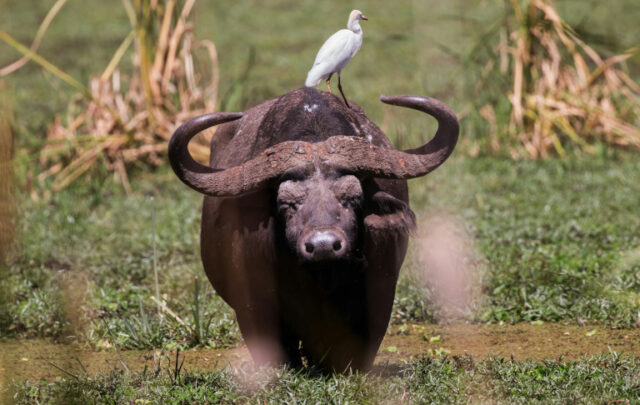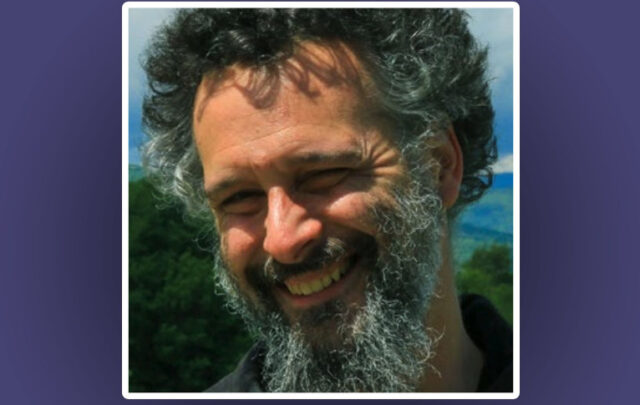
Bryan Twyman and Zora Lloyd seeding the ground at Permacultivate’s urban farm site. Photo (CC): Sarah Jacobson.
In Reading, the United States’ second poorest city, the residents’ group Permacultivate is practicing and preaching local food production.
As you enter the 2,500-foot greenhouse, you immediately notice the large 300-gallon plastic tanks to the left. A few steps closer, you can see the tilapia swimming around and realize that water is circulating to nourish the vast beds of basil, lettuce, tomatoes, and other starter plants. In the heart of Reading, Pennsylvania, the second poorest city in the United States, the Reading Roots Urban Farm project was hatched by a small group of local residents committed to charting a sustainable course for their post-industrial city.
“Five years ago a group of us got together and envisioned an effort of bringing together people around food and community. We have been evolving ever since,” says Brian Twyman, a lifelong Reading resident and social worker by trade who is passionate about exposing urban youth to ideas about the food and waste system. He credits Neil Brantley as the major catalyst for Permacultivate. Neil was the type of visionary that spreads positivity in all he touches, combined with an incredible talent for transforming the urban landscape with a minimal amount of resources. Brantley wanted to empower people through increasing their food security. The two teamed up as guerrilla gardeners who scoured the city, reclaiming blighted parcels by cleaning them up and turning them into open community gardens and green spaces. Early on, they weren’t worried about property rights – they wanted action.
Their tactics of involving neighbors and children in a community-building process attracted the attention of other committed residents. Alexis Campbell, an unassuming 20-something with a powerful vision, knew that people needed to believe in a different future for Reading. Using her innate people skills, she started bringing together other residents who met two criteria: they knew that their city was more than its dismal statistics, and they wanted to do something to improve Reading. Eron Lloyd, trained economist and community development enthusiast, joined the team and encouraged them to turn the group into a formal organization.
Empowering residents
From its roots in Brantley’s project Reading Embracing Nature in Urban Environments, the group sprouted Permacultivate as the vehicle through which to channel their efforts. Inspired by permaculture’s systems approach to designing communities and its core values, the group organized public education workshops on food systems and began strategizing an urban food production plan. Permaculture is a systems approach to embedding sustainability by applying lessons from nature to promote diversity, stability and resilience in our lived and built environments. “Permaculture is taking root in communities across the globe, but we wanted to be pioneers in bringing the ethics of permaculture to a low-income, dense, urban environment. We want to achieve urban sustainability by building community and empowering residents around their relationship with food production,” remarks Lloyd.
The dynamic team quickly built on their natural skills as educators and designers. They developed a recycling and education program in a local school to divert five to ten tons per year from the solid waste stream. They constructed a wetlands education project in another local elementary school and developed curricula for neighborhood groups, public housing residents, and elementary school classrooms. The group was committed to developing an urban foodshed program and to teaching the next generation how to grow their own food.
Following a losing battle against an absentee landowner who paved over the international food garden that community residents had come together to create, the group knew they needed a more robust plan to promote food security. As they negotiated with government officials for an abandoned two-acre parcel to start an urban farm, they encountered lots of resistance. Some critics questioned the need for urban food production when there was agriculture in the broader county. Others raised concerns that composting operations and raising chickens were unsanitary in an urban environment.

Whoa! Look at that worm. Photo: Sarah Jacobson
Getting things done
Undeterred, the group kept exploring their options. In the midst of their research, they uncovered an underutilized gem in the middle of one of the city’s parks: a greenhouse. Despite a 1994 renovation, it lay mostly vacant, serving mainly as storage for the city arborist.
The Permacultivate team, growing in number to include other gardening and permaculture enthusiasts, had already established their reputation for getting things done. With a little pressure, the city saw the wisdom of offering them a short-term lease of the greenhouse for one dollar starting in 2011. The team then got to work establishing their signature demonstration project, the Reading Roots Urban Farm.
The permaculture enthusiasts built two gravity-powered aquaponics systems entirely out of recycled material, which circulate over 4,000 gallons of water through a hybrid gravel bed/floating raft system. The system combines the best of aquaculture and hydroponics. The tilapia enrich the water and deliver nutrients to the beds of basil, cilantro, lettuce, tomatoes, and a host of other plants and herbs. The entire operation is a showcase of what a local, living economy could look like.
The Reading Roots Urban Farm had a dual mission. For one, Permacultivate intended to turn the greenhouse into a living education lab, where students and community residents could come and learn about food systems, local growing techniques, and the principles of permaculture. They brought in classes of elementary and high school children and supported community volunteers who wanted to learn a basic life skill that many urban residents had lost their connection to: growing food.
Ripple effects
At the same time, the group wanted to have an impact on the local economy. They knew that true economic resiliency included a population who could produce their own food. They began raising herbs and lettuce for sale at the local farmers’ market and to local restaurants. By localizing restaurant supply chains, the group could help increase the local economic multiplier, meaning that a dollar spent in Reading would have more economic impact. Today, after three years in operation, the greenhouse annually produces over 1,000 kilograms of food available for local consumption.
The initiative has had several ripple effects in the local community. People no longer question the idea of growing food in the city, and the number of community gardens has increased by a factor of four. The City Council of West Reading is contemplating an urban farm ordinance, which will permit residents to raise a range of animals from ducks and rabbits to bees. The city has developed a commercial recycling program that is positioned to divert over 275 tons of solid waste per year from landfills. Members of Permacultivate continue to give educational workshops on a range of issues, from composting to mushroom cultivation. And the group has now turned its attention to the area surrounding the greenhouse, where it intends to plant an edible fruit orchard. “We’re only just beginning,” exclaims Twyman. “This is about changing a culture. We know it will take time, and this is just a small first step towards our Reading transformation!”





